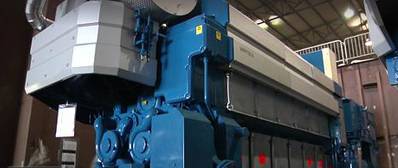German Ferry Dual-Fuel Propulsion Package Order for Wärtsilä
Wärtsilä say they are to provide a full propulsion package for a new passenger ferry being built for the Germany based ferrry operator Reederei Cassen Eils GmbH at the Fr. Fassmer GmbH shipyard.
The new ferry will operate between Cuxhaven and the island of Helgoland in Germany. This route will take it close to the Lower Saxon Wadden Sea national park, an ecologically sensitive UNESCO World Heritage listed area in the south-eastern part of the North Sea. Because of the need to minimize exhaust gas emissions in this area, the ferry will operate primarily on liquefied natural gas (LNG) using two 9-cylinder Wärtsilä 20DF medium-speed dual-fuel engines.
The selected engines are the latest generation of the Wärtsilä 20DF series. They offer an increased output of five per cent and a reduction of seven per cent in fuel consumption in gas mode, compared to earlier versions of the engine.
In addition to the propulsion machinery, Wärtsilä will also supply its LNGPac fuel bunkering and supply system with related safety and automation systems. The scope of supply also includes Wärtsilä's patented Cold Recovery System, which utilises the latent heat of LNG in the ship's air conditioning systems, thus reducing the amount of electricity consumed in cooling compressors. This provides significant operational savings and an increase in overall vessel efficiency, while adding to the environmental benefits of the Wärtsilä solution.
Scope of Supply:
- 2 x 9-cylinder Wärtsilä 20DF dual-fuel engines each with an output of 1665 kW
- 2 x Wärtsilä gearboxes with 700 kW PTO/PTI 2 x 2600 mm diameter Wärtsilä Controlled Pitch Propellers
- The Wärtsilä LNGPac fuel bunkering & supply system with 53 m3 LNG storage tank
- Wärtsilä Cold Recovery system
The vessel is scheduled to be delivered and ready for service during the first half of 2015. Earlier in 2013, Wärtsilä was also contracted to retrofit the 'Ostfriesland', a ferry operating in the same environmentally sensitive waters, for LNG fuel use.













